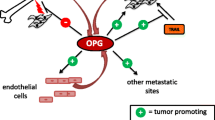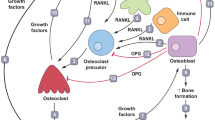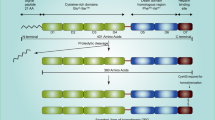Abstract.
Osteoprotegerin (OPG) is a soluble tumor necrosis factor receptor family member, which potently inhibits RANKL-mediated osteoclastogenesis. Numerous constructs have been created for therapeutic purposes in which the heparin-binding and death homology domains of OPG were removed and the remaining peptide (amino acids 22–194) was fused to the Fc domain of human IgG1 (OPG-Fc). The administration of OPG-Fc efficiently counteracted bone loss in a variety of preclinical models of cancers. However, several in vitro studies have shown that native or recombinant full-length OPG not only neuralizes RANKL, but also the death-inducing ligand TRAIL, suggesting that OPG might potentially counteract the anti-tumor activity of TRAIL. Additional evidence suggests that full-length OPG possesses RANKL- and TRAIL-independent biological properties, mainly related to the promotion of endothelial cell survival and angiogenesis. Finally, breast tumor cells overexpressing OPG have shown increased bone metastatic potential in vivo. The relevance of these apparently conflicting findings in tumor cell biology is highlighted.
Similar content being viewed by others
Author information
Authors and Affiliations
Corresponding author
Additional information
Received 2 September 2008; received after revision 29 September 2008; accepted 13 October 2008
Rights and permissions
About this article
Cite this article
Zauli, G., Melloni, E., Capitani, S. et al. Role of full-length osteoprotegerin in tumor cell biology. Cell. Mol. Life Sci. 66, 841–851 (2009). https://doi.org/10.1007/s00018-008-8536-x
Published:
Issue Date:
DOI: https://doi.org/10.1007/s00018-008-8536-x




